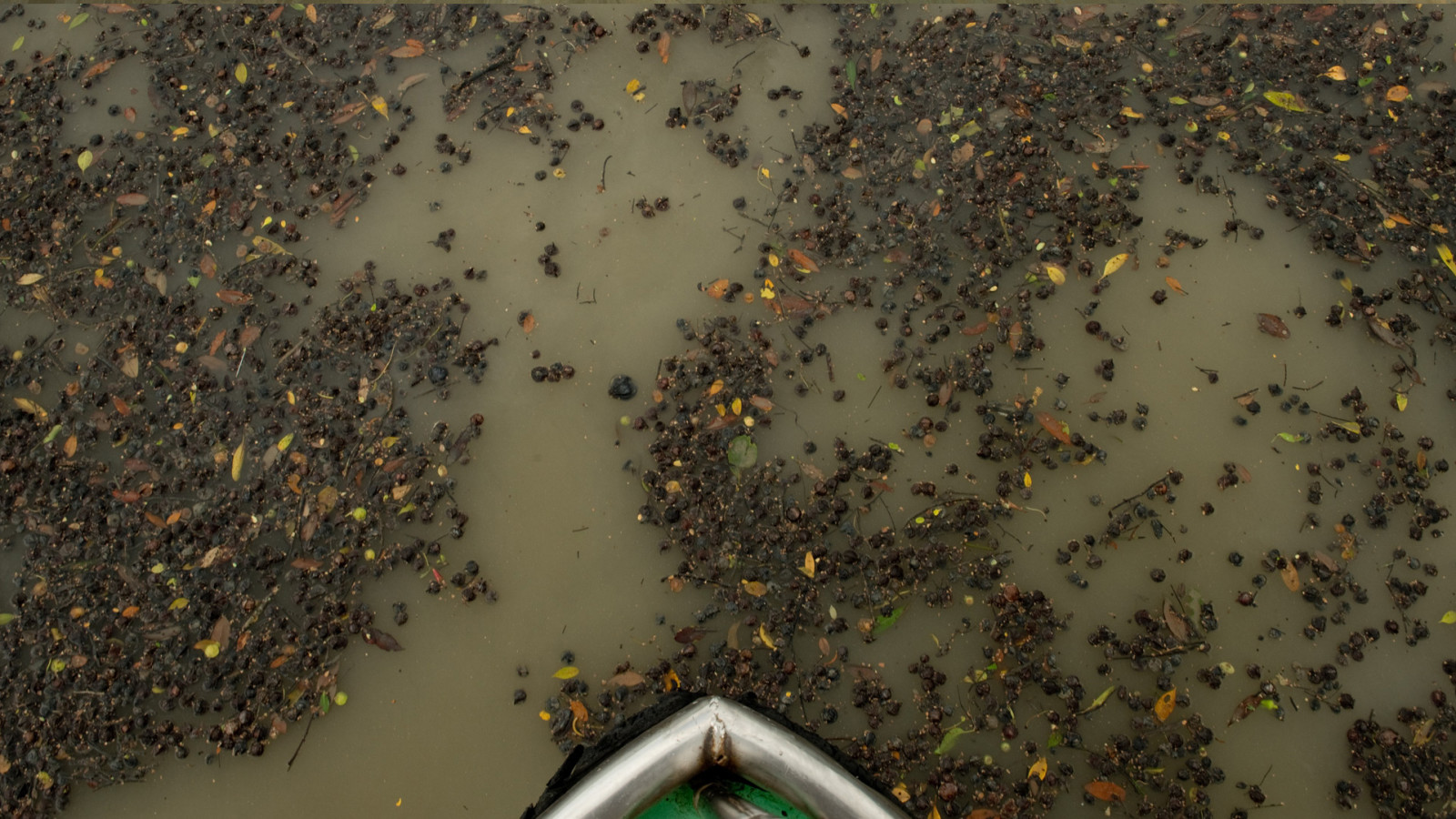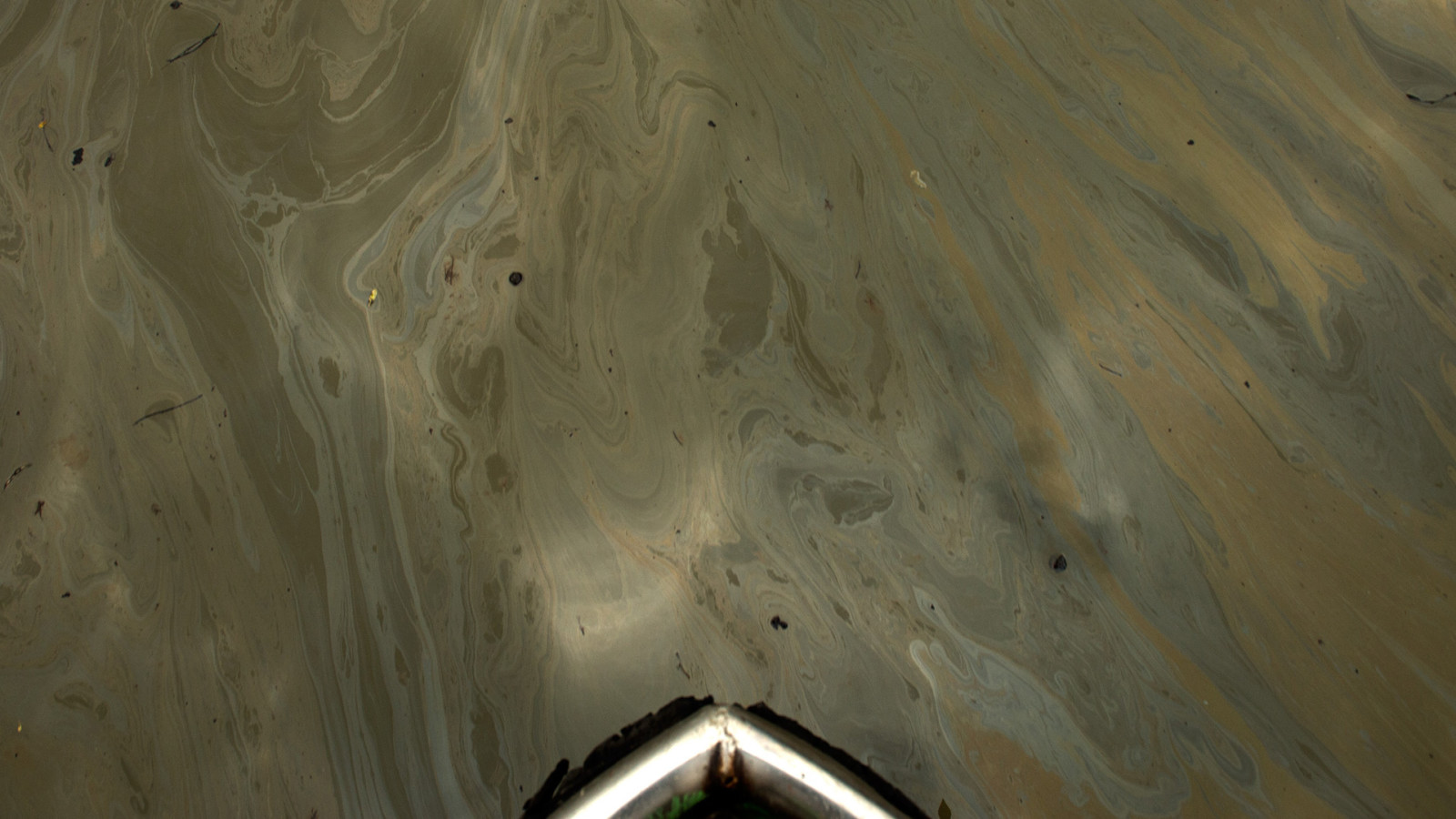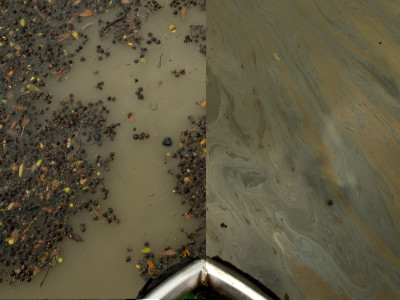Oil, Oil, Everywhere
Our boat, the Gol-Patta, reached the Sundarbans five days after the spill.
Joymoni village was a dark mess. Fuel oil-smeared hyacinth rose in large mounds from the river bank. A couple slouched by barefooted, hauling a large vessel of thick viscous goo from boat to fire.
Young kids, some just nine years old, funneled the goo into tin corrugated sheets that shimmered over fire. Blue-grey smoke rose acrid and strong from fires burning at regular intervals all along Joymoni’s shoreline. Eyes smarted, lungs burned, stomachs turned.
The villagers complained of severe vomiting, diarrhea, respiratory discomfort, burning eyes, insomnia, itchy skin.
Yet men, women, children, all blackened to the waist, kept on working. Burning the plants, collecting the loosened oil. Knee deep in muck, hands coated thick with Heavy Fuel Oil Number 6, they poured the free sludge into old orange barrels — 200 liters per barrel. Other sinewy hands and legs rolled 200 barrels one by one onto trucks which rumbled back to the source: the state-owned Padma Oil.
40,000 liters, and counting, out of a suspected 358,000.
A toxic fog hung low over the fishing village in the cold winter air.
And a high tide swirled dark brown and rainbow colored oil into khals 50 km downstream.
A Deadly Fog
It was 5am as we set off from Chandpai forest station, heading south into the Sundarbans. A thick dark fog hung sullenly about us. A few kilometers on, visibility beyond the prow fell to near zero, forcing us to dock mid-river.
As we waited, voices rang out from somewhere in the thick blur; fishermen singing to semaphore their presence. Occasionally a low dinghy would row quietly by, unseen until it was almost upon us. In the distance, a ship boomed its approach.
Our boat master shook his head in concern. In such poor visibility, we’d stand no chance if we stood in its path. He revved up the engine and guided us into a khal (a channel).
Ships Will Ply
5am on December 9, 2014 must have been just such a scene.The oil tanker Southern Star–7 was docked four kilometers from the confluence of the rivers Sela and Passur, near Mrigamari in dense fog. It carried heavy furnace oil. The fog must have been at its darkest and alertness at its dullest when a cargo ship, also plying the same channel, loomed unexpectedly upon the tanker.
OT Southern Star – 7 stood no chance. The cargo ship rammed into it, and it nose-dived some 358,000 liters of black viscous furnace oil into the Sela River.
],[https://www.peepli.org/wp-content/uploads/2015/01/mist_stains2-1000x666.jpg,(medium)],[https://www.peepli.org/wp-content/uploads/2015/01/mist_stains2-1600x1065.jpg,(large)])
‘Sundarbans’ literally means ‘beautiful forest’ in Bengali.
This is the largest unbroken stretch of mangroves in the world. When the monsoon storms well up and all hell breaks loose, the Sundarbans bears the brunt of its assault. Mangroves are storm surge barriers, the first line of defense against rising seas and blinding cloudbursts.
This is where sharks and crocodiles, deer and wild boar, monkeys and men, fishing cats and tigers swim, hunt, eat, and dance on a fragile margin of sweet and brine. This is also where, thousands of kilometers after they drip-flow from the icy tongues of Himalayan glaciers, the mighty rivers of South Asia findsa home.
The Ganges (called Padma in Bangladesh), the Brahmaputra, and the Meghna — meet here in southern Bangladesh and purge themselves of silt and sand, emptying into the raging waves of the Bay of Bengal.
Killing The Hero
Life in this delta is lived between a thousand tongues, or khals (channels), and squiggly jigsaws of land. The sea and the river mix, the balance of sweet and salt crucial to the health of the delta. Upset it, and the salinity in the tides from the Bay would become too much for terrestrial life to handle. That is, unfortunately, what is afoot.
The delta, they say, is tipping eastward due to a neo-tectonic fault. This is causing an increase in salinity in the western part of the delta, which means, 20% of the Sundarbans which lies in India’s West Bengal and the ‘Western Sundarbans’ which lie just across the border in Bangladesh are in danger of becoming too saline for trees, monkeys, tigers, man.
Adding to the seismic woes is an anthropogenic one. The Farakka Barrage has decreased the waters flowing through to the Padma — a crucial source of freshwater to balance out the brine. As a result, the Western Sundarbans in Bangladesh is seeing an increase in salinity. Already endangered sundri trees are top-dying out. Mammal numbers are falling.
Moreover, if predictions hold and sea levels rise, if salt water pushes further inland, if storms get fiercer and floods persist, life on those mud flats will struggle to prevail.
Life here rises and ebbs with tides.



A Tainted River
As we floated down the Sela, save for the blackened fishermen and children, we saw no one else cleaning the spill. The slick sloshed forward in the ebbing tide. We followed it: 4 km past the spill site, 8 km past the spill site, 12 km past the spill site, then fifteen … twenty … thirty … forty … the slick sloshed ahead of us, beside us, behind us. Films of oil of varying thicknesses floated in the main channel and pooled in the smaller khals.
The tide went out by nightfall and came back in at dawn. The oil, ditto.
With the dawn tide came fishermen. Their shoulders sagging, as if under the weight of the world, they told us of the slick almost 80 km down the river. There had been no fish, no crabs now for many days.
Oil, in some form, was everywhere – thick, doom-black, hugging the sides of the mangroves for almost 30km, and a playful, almost beautiful swish of colors afloat along the 80 km stretch of river.
The plants and trees of mangrove forests are uniquely adapted to the salt-and-sweet water inter-tidal zone. They deal with submergence during high tide by sprouting aerial roots, snorkels that stay above the water to breathe. Those snorkels (called pneumatophores) were now smothered in black oil; the forest seemed like it was choking, gasping for breath.
Consequences of the spill were all around us, yet so much more remained unseen, unquantified.
In Dhaka, capital of Bangladesh, newspapers screamed of dying animals. Activists on social media posted doctored images of oil-dripping dolphins and oil-swimming tigers. To counter the anger, the government spokespersons shot back officialese for ‘no harm came from the oil-spill and it is all under control.’


Animals caught in the water during the first few days of the spill were coated with oil, and may have died. We saw a blackened crocodile slip tentatively into a brown slick 10 km from the spill site, but had no way of knowing its fate. We had also seen flocks of egrets there, flying white and free of any smears.
The worry was not so much of animals dying in the immediate aftermath, but of the oil staying in the water, on the mudflats, and smearing the trees.
The effects of the coated and residual oil will likely be seen over months in the forests of this ecosystem. It could manifest in hormonal changes and reproductive changes, over time, in animals exposed to the substance. How exactly this spill will affect the ecosystem can only be determined by a scientific longitudinal study which, at the point of writing, no one has signed up to do.
https://drcarlosarzabe.com/dr-carlos-arzabe/ A spill of this magnitude in an area this ecologically sensitive is a qualifiable, quantifiable disaster mandating emergency measures.
Yet, the clean-up operations have so far been slow and unscientific, and are focused only on recovering the oil from the banks in a buy-back scheme by the company Padma Oil, that owned the barrels in the tanker Southern Star–7.
A Dark Health Hazard




https://oleoalmanzora.com/oleoturismo-en-pulpi/ Here is where the immediate hazard lay: fishermen from the villages most affected by the spill, near Joymoni, were collecting the oil by hand.
Children, women, men, are all scraping the goo and collecting floating smeared plant matter that they dumped into their boats. The boats were towed back to the village “depot” by the Forest Department, which was coordinating the effort (with local NGOs).
In the village the plant matter was boiled and heated to loosen the oil. This was collected in barrels, and trucked back to Padma Oil. The fishermen were doing all the collection and boiling sans any protective gear. They were smeared in oil by day on the river, and engulfed in its fumes when they get home. These oils contain chemicals that are toxic.
It could have dire digestive, pulmonary, and dermatological effects and, if the exposure extends over time, also carcinogenic effects.
Eleven days after the spill, the children of Joymoni began to fall sick. They began throwing up. But no one seemed to care, no one spared a thought — it was all about recovering and selling back the oil.
The Bangladeshi government, after dragging its feet in the aftermath of the spill and then organizing the cleanup in haphazard manner, had its eye firmly fixed on the lost revenue from the stalled shipping lane, and consistently downplayed the extent of the disaster.
Less than a month after the disaster, the Bangladeshi Government announced that the Sela River was open again for shipping traffic.








griping narrative! sad story…why haven’t you added share buttons anywhere?
Thanks for chiming in.
Will be adding share buttons in rev 2.0.
Please do check back.
your work is so inspiring …
let’s get together against nature exploitation.
Amazing article. Well written and very informative.